The 3F UL Lanshan 1 Pro Tent is an ultralight single-wall trekking-pole tent with a side door and vestibule that can be rolled back in good weather for ventilation and views. The interior has a fully integrated bathtub floor, so you can pitch the tent in the pouring rain and still keep the interior dry. The tent is made with silicone impregnated nylon (silnylon) and must be seam-sealed manually before use in rainy weather. This is an easy process that only takes about 30 minutes to complete and a day or two to dry.
Specs at a Glance
- Type: Trekking Pole Tent
- Manufacturer’s Claimed Weight: 24.4 oz / 690 g (includes factory attached guylines)
- Weight after Seam-Sealing: 24.4 oz / 690 g (includes factory attached guylines..that’s not a mistake. Our tent was obviously lighter than the manufacturer’s specification before seam-sealing)
- Doors: 1
- Recommended Pole Height: 120 cm
- Material:
- Fly: 20 D double-coated silicon nylon
- Floor: 20 D PU-Silicon coated nylon Waterproof index: 6000mm
- Mesh: 15 D Nylon mesh
- Zipper: YKK #3
- Minimum # of States to Pitch/Recommended: 6/9
While its design shares many features that are common on other tarp-style tents. the Lanshan 1 Pro is remarkably similar to the Six Moon Designs Lunar Solo. The biggest difference between the two is that the Lanshan 1 Pro is made with silnylon which tends to sag a bit when it gets wet, while the Lunar Solo is made with polyester, which doesn’t. Both tents still need to be seam-sealed to waterproof them and both tents are made in China.
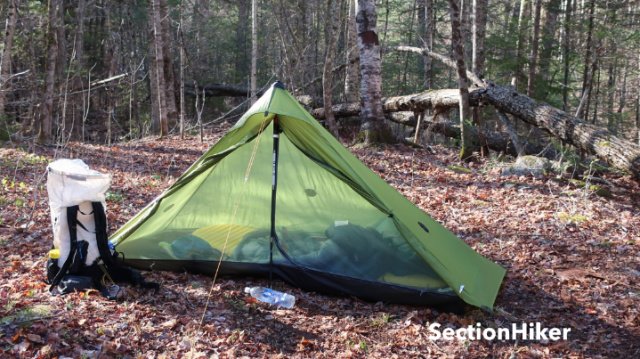
Tent Exterior
The Lanshan 1 Pro has a large front vestibule, split down the middle with a zipper, for covered gear storage. The bottom of the vestibule does not reach the ground but is raised to facilitate airflow. Single wall tents are prone to tent condensation and the extra airflow helps minimize the amount of moisture that collects on the inside of the tent. There’s also a vent in the peak of the tent to release the warm air the collects near the ceiling and causes internal condensation to form.
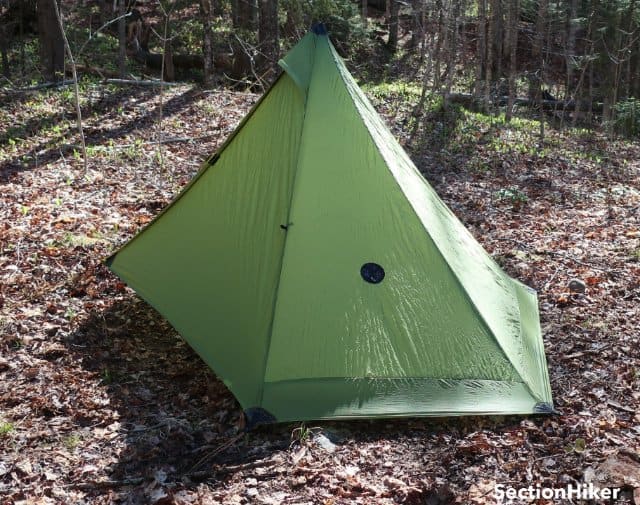
The tent requires 6 stakes to pitch at a minimum: 5 on the corners and 1 in front of the vestibule. All of the guyout points, including the peak and panels, are reinforced with UHMWPE-gridstop. While you don’t have to seam-seal the fly corners, you will want to seal the needle holes in the reinforced patches on the peak and panels.
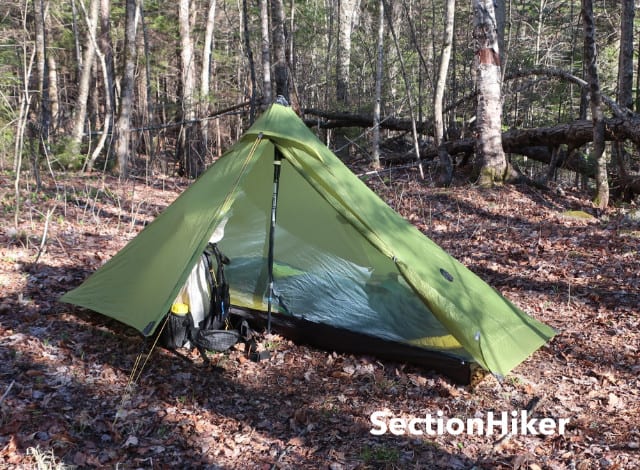
When you set up a trekking pole tent like this, it’s best the keep the guylines loose when staking it out and then tighten them once you’ve inserted the peak pole. All of the guyout points have lineloc tensioners, which makes this easy. There are additional panel guyout loops on the side and rear wall and I would also recommend using them to increase the tent’s interior space and headroom, particularly in wet conditions.
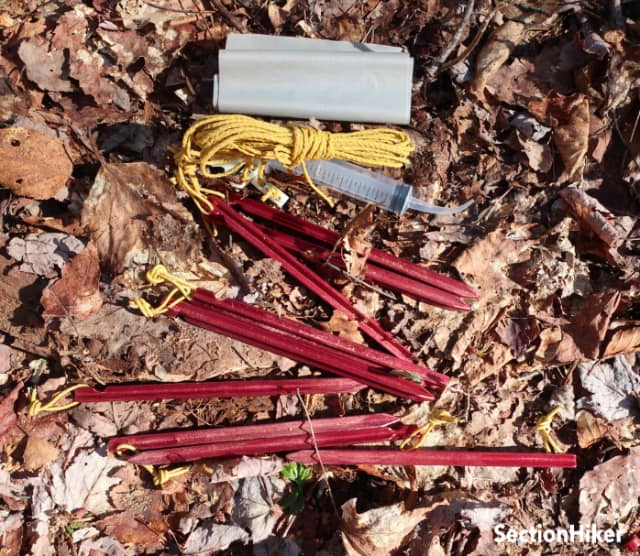
Tent Interior
The Lanshan 1 Pro has a floating bathtub floor that is connected to the tent walls with mesh. This makes it a little easier to pitch the tent on uneven ground while facilitating more airflow through the tent. The rainfly extends out over the mesh so rain hitting the tent exterior doesn’t drip inside the tent, while internal condensation is designed to roll down the interior walls and out through the mesh. This latter feature isn’t that reliable, however, because surface tension often keeps the water from draining through the mesh. Your best bet is to carry a small towel to mop it up if it ends up dripping on the door. It’s only a small quantify of water.
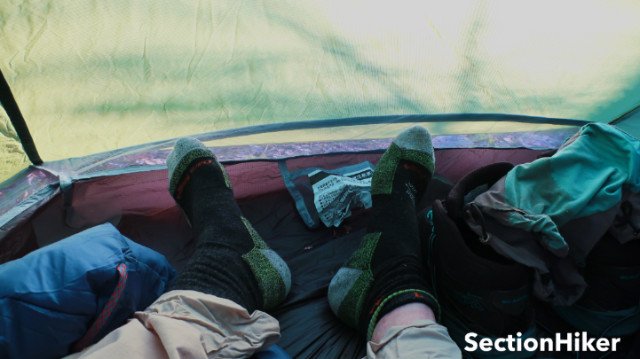
The bathtub floor has a five-sided shape, so it fits a rectangular sleeping pad and has space for extra gear storage alongside your pad inside the tent. It’s big enough for a medium-sized dog. There is however, only one small mesh pocket on the interior of the tent, located at one of the ends.

The corners of the bathtub floor have guylines attached that can share a stake with the corners of the fly. These interior guylines give the bathtub floor its height, to prevent standing water from entering the tent. It’s a nice detail.

Packaging
The Lanshan 1 Pro comes with a compression sack, attached guylines, extra guylines, a seam-sealing syringe, and 10 tent stakes. You do need to purchase silicone-based seam-sealer separately though. We dilute ours 50/50 with white gas so that it soaks into the seams more easily and then paint it on with a small brush.

The Lanshan 1 Pro packs up quite small when it’s stuffed into its stuff sack, making it very easy to carry in a smaller volume backpack.
Recommendation
The 3F UL Lanshan 1 Pro is a solid value for the money. While silnylon tents have been somewhat eclipsed by ones made with polyester because they don’t stretch when they get wet, silnylon is still a highly packable fabric that will last a long time with proper care. While there is some benefit to buying a polyester Six Moon Designs Lunar Solo ($260) instead, the Lanshan 1 Pro is still a perfectly good tent in its own right. If you’re on a tight budget or you want to try using a single wall tent without going bankrupt, the Lanshan 1 Pro is a good option.
Lanshan 1 Pro Tent
Comfort
Ease of Setup
Weather Resistance
Durabilty
Weight
Packed Size
Disclosure: The author purchased this product.
SectionHiker is reader-supported. We only make money if you purchase a product through our affiliate links. Help us continue to test and write unsponsored and independent gear reviews, beginner FAQs, and free hiking guides.
 SectionHiker.com Backpacking Gear Reviews and FAQs
SectionHiker.com Backpacking Gear Reviews and FAQs 
What are the actual measured dimensions compared to the manufacturers listed specs? I’ve heard it’s for smaller hikers only, was that your experience?
I found it to be huge inside. I use a 6’ pad with room to spare on the ends. Plenty of head room and width. I’m on a trip now but will measure the insides when I get pack and post them.
Thanks for the detailed reviw. I showed this to a buddy that is 6’4″ and uses a long-wide pad. The floor is larger than most 1 man tents, about 90 in. long, 39in.wide in the middle, and 31.5 in.wide at the ends. Plenty of room for a long-wide pad and some gear.
The end panel pullouts should provide plenty of head room for my tall friend. Only the Tarptent Protrail has a floor as large, but he prefers a side entry. Some UK hikers have tested this tent in Scotland winds and rain and it held up well. Quite a deal for a tent of this size and weight.
The market for more affordable less expensive gear is growing. You have to be choosy but there are some decent finds. There’s also a huge amount of crap. This tent is a good value though.
Still, if it takes 6/9 states to pitch, you’ll have trouble finding a spot.
It’s pretty easy to find a spot for this tent actually.
Do you know the difference between the 3-season vs 4-season version listed on their site?
nope. Why don’t you contact them and ask.
The 4 season is a fabric inner and the 3 season is mesh
There are very few trekking pole tents in the market that require less than six sticks pitch. The TarpTent Pro Trail only requires 4, but has front entry rather than side entry, which can be restrictive, and I understand it is also really bad with condensation. I’m sure the. Lanshan isn’t much better with condensation, but for $100 less, I’ll take my chances.
Amazon link now shows the 3F UL GEAR Lanshan 1 pro tent at $187 (5/23, 9:30 PM)
It goes up, it goes down. Probably depends on their inventory.
Begs the question on seam sealing – why the syringe but no sealer and why white gas as opposed to another solvent?
You can use paint thinner too. Get the real stuff though.
They just didn’t include seam sealer. I’m pretty sure Tarptent doesn’t either. That’s not abnormal.
Good review and greetings from the UK. For the money this is a great lightweight backpacking tent ( and l’m of an age when ultralight is a necessity rather than a preference). I’ve used this for over a year in some strong winds and heavy rainfall and its held up well.
One tip as with all single skin tents, condensation is an issue. To improve airflow and minimise this, you need a high pitch with the fly at least two or three inches from the ground, so l set the trekking pole at 130cm rather the 125 recommended. At night, unless is raining or rain is forecast l also leave both the inner and the fly partially unzipped.
Good review of a tent I’d seen last year on YouTube. Now I know more about it from a trusted source.
Chinese build quality is constantly improving in many product areas. I bought my grandsons a Chinese Fire Maple Blade 2 remote canister backpacking stove that has very good design, materials and build quality.
My experience with Chinese aftermarket parts for my 2019 MAZDA CX-5 has been, to my surprise, very good. From gas hood struts and stainless exhaust tips to interior trim pieces I have only good things to say about Chinese aftermarket automotive parts.
So, much as I dislike Chinese foreign policy I put that aside when buying Chinese backpacking gear. My Tarptent Gen. 2 Notch Li Dyneema fabric tent is made in China and is “Hilleberg quality”. My Chinese down pants are likewise well made with some upgrades that make sense like inner leg cuff areas that are of tougher material to withstand boot abrason.
Thank you, this review was most helpful. I didn’t want to spend a fortune on a hiking tent that I am probably only going to use once for a hike in Scotland. I have taken into consideration the sag tendency in wet weather (Scotland), but I still think it will be ok.
Sag never harmed anyone. And it doesn’t rain all the time in Scotland anyway.
I have this tent and have pitched it and used it in rain. The sag was very, very minimal. And if you want to tighten it up, it’s a very quick and easy process.
The 2021 Lanshan 1 XL is 80 x 230, tape sealed, 740g and has a T door which is just great!
Honestly can’t see why people would get the Lanshan Pro over the Plus XL
it would be worth reviewing that.
It requires a few easy mods to get the most out of it but I’m amazed at how
much tent I’ve purchased for a mere £130 to replace my ailing old Lunar.
A url that shows how to properly steam seam would be nice.
Great article.
I just camped for 8 days in Nova Scotia. One night it rained 2”. The tent was dry. Little condensation. Lots of room for 1, plus gear. I’m 5’11”.
I own a Lanshan One XL, it comes already steam-sealed. It weighs less than 1kg and it has never leaked. My mesh inner is a ‘T’ zip system rather than a ‘J’ zip type. It means that once my mesh inner is opened up I can put everything in my tent without having to bend down. So easy. I’m 5′ 6″ so there is plenty of room inside and I can sit upright as well. I camped for 51 consecutive days when I hiked the GR10 route across the French Pyrenees last year and my tent still looks like new. It has one drawback (for me a minor one) it’s not freestanding. The ground was as hard as concrete at the Mediterranean end of the walk, I couldn’t use my pegs, so I had to lay the tent flat, fit all of my stuff into it and then sleep with the tent loosely draped over me like a bivvy. It worked fine. It’s also a versatile tent, if I take the inner mesh out I can also use it as a tarp, and if it rains I just close it up with the entrance zip. For me, a very good buy and ideal for my type of hiking.
Love mine… i own both versions but for the tiny weight difference i prefer the lanshan 2 for space.
Both will work fine. Never had issues.
You will get some condensation but easy to wipe it off.
Pack small, easy pitch, sturdy and lightweight.
I have just bought the pro. Not used it tet. I did use the original 1 person lanshan though. I took it on a three week solo cycle tour from Italy to Amsterdam. It handled everything. It rained for 5 days solid in Germany, not one issue. Marvellous tent it was. After the 3 weeks and a bit of use back in the UK it started to sag. Don’t know if I over tightened or it was due to summer heat but it was never the same. Lasted about 2 month of near every day use though. Hoping the new version is as good if not better.
I’ve just come back from a week’s hiking in Madeira, what a beautiful island, very lush, mountainous and steep. I took my Lanshan One XL with me and on two nights I had to use it as a tarp. My tent is not freestanding, and being so high up I just couldn’t find anywhere soft to push my pegs into, but I was successful on four nights.